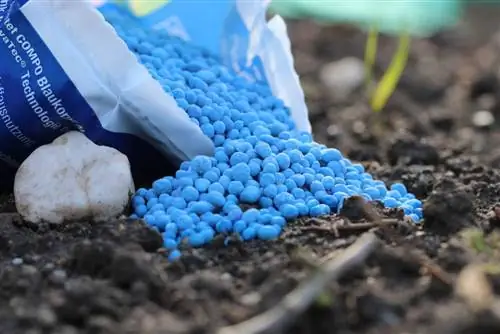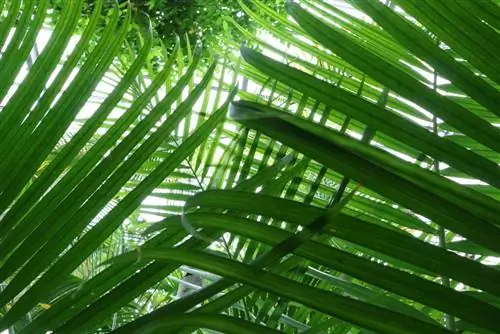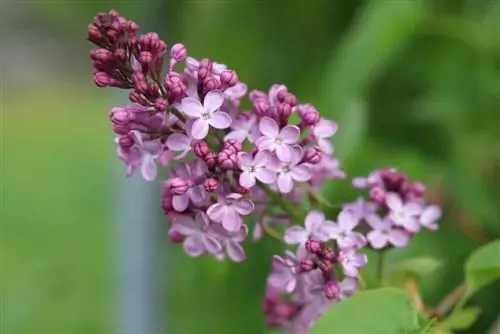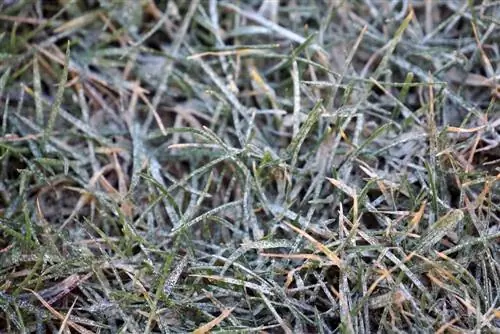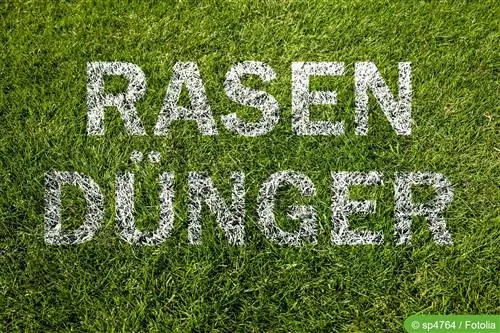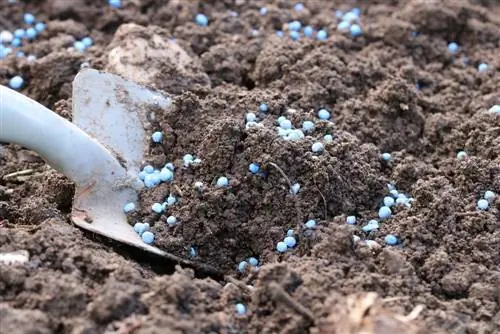- Author admin [email protected].
- Public 2023-12-17 03:39.
- Last modified 2025-01-24 12:45.
A velvety green lawn carpet is considered an accolade among hobby gardeners. To achieve this goal, the blue beads of a well-known fertilizer are available to stimulate sluggish grasses. As a purely chemical preparation, blue grain fertilizer is still controversial. The rapid effect of nitrogen, phosphorus and potassium on a green area cannot be ignored, nor can the harmful effects of the purely chemical ingredients on nature. So the question arises as to whether blue grain fertilizer is recommended for the lawn or not?
Composition and mode of action
In order to be able to answer the question about the pros and cons, the exact effect of blue grain fertilizer on the lawn must be known and what ingredients it is based on. We have therefore compiled all the important properties of the complex fertilizer below:
- Complete chemical fertilizer, consisting of the core nutrients nitrogen (N), phosphorus (P) and potassium (K)
- Other ingredients: magnesium and trace nutrients on a chemical basis
- Common concentration of NPK: 12+12+17 plus 2 for magnesium
- For better identification in the form of blue-colored, water-soluble grains
Blue grain is the most commonly used fertilizer in commercial gardening and landscaping because it develops its growth-promoting effect within a short period of time. About 2 to 3 days after administration, the lawn grasses respond to the concentrated load of nutrients. Deficiency symptoms disappear, the noble grasses take on a lush green color and growth continues rapidly. Nevertheless, the effect lasts for 2 to 3, a maximum of 4 weeks, without causing a lasting, positive reaction in the lawn. This is based on the fact that Blaukorn does not contain any organic materials, but only immediately available chemical ingredients without a sustained release effect. However, it is precisely these plant or organic ingredients that the soil organisms feed on in order to transform them into valuable humus, which benefits the soil in the long term.
Refertilization results in overdose
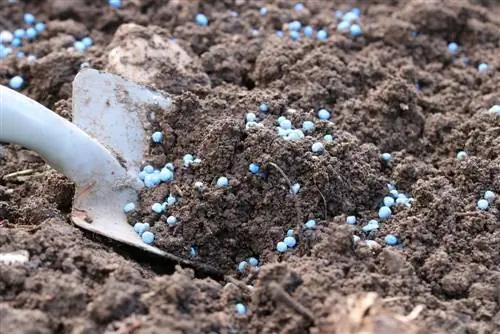
In view of the short-term effect on the lawn, it is obvious to simply re-fertilize once the desired effect on the lawn has worn off. This is where the negative sides of chemical complex fertilizers become apparent. If blue grain is fertilized again in a timely manner, the soil will be overdosed and the environment will be significantly damaged. In particular, the excess is washed into the groundwater in the form of nitrate, with the risk of he alth risks. In drinking water, nitrate turns into nitrite, which in turn mutates into cancer-causing nitrosamines in the intestines. Babies, older people and pets and farm animals are particularly affected. In addition, over-fertilization causes burns on the grass roots, causing the noble grasses to die.
The earliest you can fertilize is 4 to 6 weeks after the first application of the blue grains. By then, the lawn will show all the deficiency symptoms that prompted it to resort to the chemical bag of tricks. As a result, a bottomless pit opens up here.
Recommended as a short-term problem solver
Although the repeated application of blue grain is questionable, the complex fertilizer acts as a quickly effective problem solver. If the lawn consistently refuses to grow densely, velvety green, the stimulating effect of the blue granules definitely has its advantages. This applies primarily to the start of this year's gardening season. Since the purely chemical agent cannot be used at high temperatures and in prolonged dry conditions, it is particularly effective in March and April. How to do it right:
- A date with warm, overcast weather is well chosen
- The lawn must not be completely dry
- Set the fertilizer cart to the dosage recommended by the manufacturer
- Walk along the lawn during fertilization without overlapping
The subsequent irrigation of the fertilized green area is of utmost importance. If necessary, repeat the watering in the following days until all fertilizer grains have dissolved. Only then can you mow for the first time.
Tip:
It does not make sense to dissolve blue grain in water to use it as liquid lawn fertilizer. In this case, the hoped-for effect will come to nothing because the nutrients cannot act on the noble grasses for long enough.
Organic fertilizer continues the blue grain effect
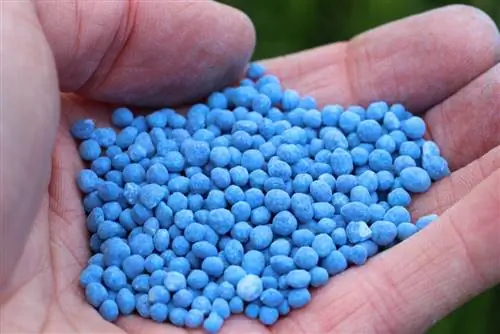
While the multi-nutrients of blue grain exert their growth-promoting effect on the suffering lawn, the time has come for organic fertilizer with its long-lasting strengthening of the grass. After the blue grains have seeped into the ground as a result of extensive irrigation, organic fertilizer is applied to the green area. Suitable materials for your green carpet are:
- Sifted, mature compost
- Horn shavings or horn meal
- castor bean meal
- Soybean meal
- Plant cessation, e.g. B. from nettles and comfrey
When combined with blue grain, organic fertilizer seamlessly continues its positive impact on grass growth for the rest of the season. Now the busy soil organisms do their useful work and break down the natural materials so that they are available as nutrients for the lawn grasses. In this context, please keep in mind that an overdose can also occur when applying organic fertilizer. If significantly more than 3 liters per square meter are administered, in the worst case there will be up to 400 earthworms per square meter. The result is destroyed roots and dying noble grasses.
Soil analysis creates clarity
Stunty lawn, bare spots and dull colors do not necessarily indicate a need for fertilizer. On the contrary, these can certainly be symptoms of mineral or organic over-fertilization. Therefore, first put all the basic conditions to the test before you use blue grain fertilizer. If the location, soil conditions and water balance meet the requirements of a lawn and it still does not thrive, a professional soil analysis provides final certainty. A special laboratory examines the soil sample you have taken and, in addition to the specific result, gives helpful recommendations.
Innovative Blaukorn Entec
Classic blue grain fertilizer for lawns has the disadvantage that the nitrogen it contains is washed out into the drinking water within 2 to 3 weeks, polluting the environment and he alth. The newly developed product Blaukorn Entec delays this undesirable process for up to 10 weeks. The nutrients are available to the lawn grasses for much longer, which results in highly effective use. Before nitrogen is washed out, a large part of it has already been utilized, which noticeably reduces nitrate pollution. If a short-term effective complex fertilizer is required for the lawn, more and more hobby gardeners and commercial businesses are turning to Blaukorn Entec.
Conclusion
The question of whether blue grain fertilizer is recommended for lawns or not is still controversial. The proponents argue with the rapid availability of nutrients for the noble grasses. The majority of opponents justify their rejection with the harmful effects on human he alth and the environment. Since both lines of evidence cannot be dismissed out of hand, prudent hobby gardeners prefer the golden mean. As a short-term problem solver for a suffering lawn, the turbo effect of blue grain fertilizer is definitely recommended. The nutrient supply only achieves a truly sustainable effect in combination with an organic fertilizer, which converts the stimulating effect of the blue grains into a long-term effect.

